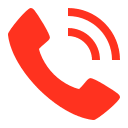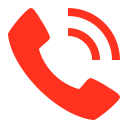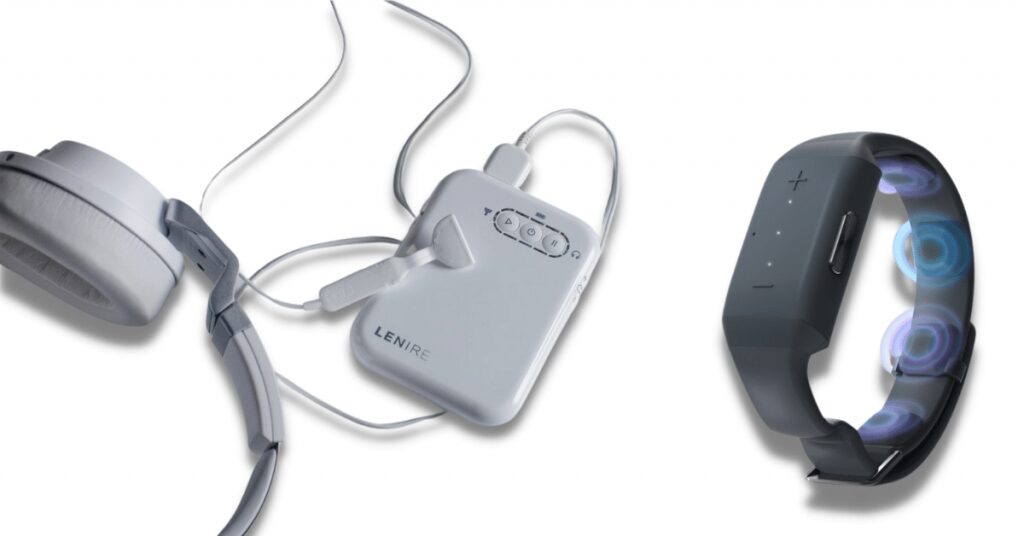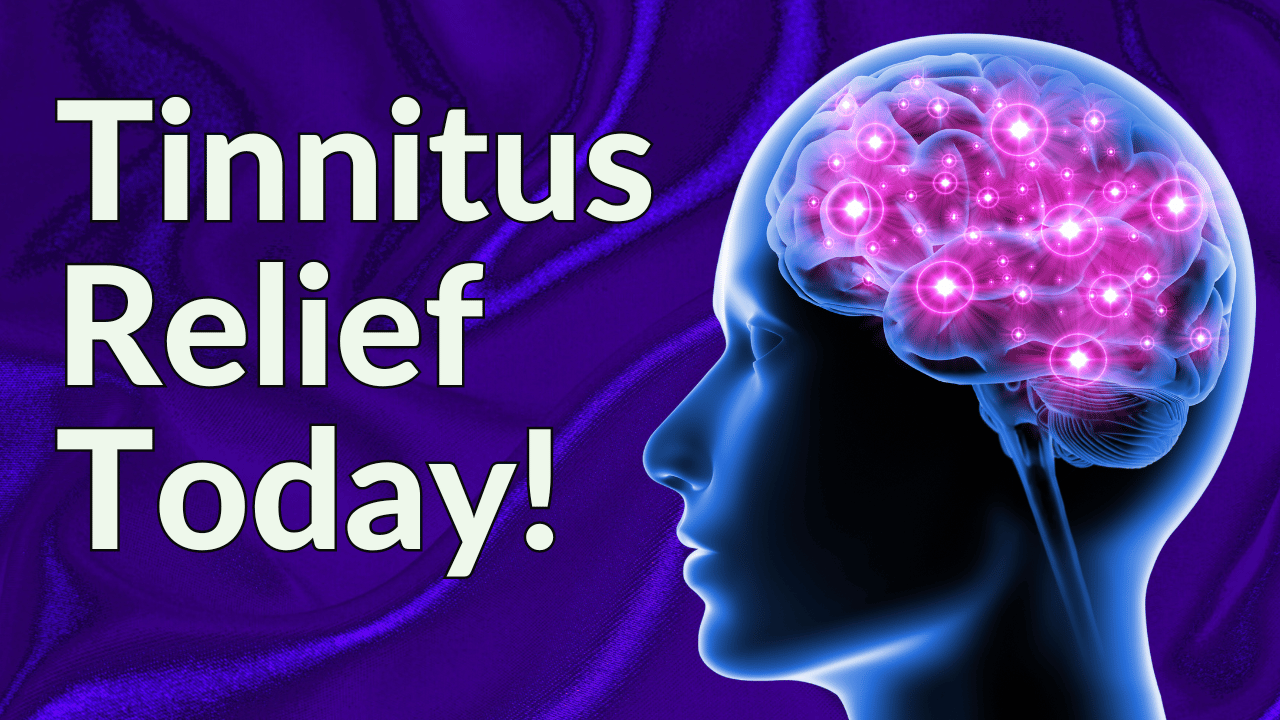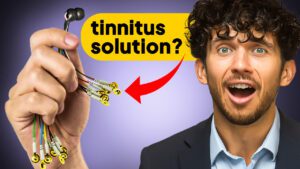**Update: As of March 7th, 2023, Neuromod’s Lenire device has been granted FDA approval for bimodal stimulation, and can now be used by tinnitus patients in the United States.
In this article, I will explain my own independent research into the two newest tinnitus products, the Neosensory Duo and the Neuromod Lenire device. (Full disclosure: Pure Tinnitus is contracted by Neosensory to provide tinnitus consultations for the pro version of their product; however, the purpose of this article remains to discuss these different devices in a transparent manner and offer suggestions for whom they might be good for.)
The classic treatments and therapies for tinnitus are either psychological—which addresses the limbic system and the emotional charge of the brain—or auditory, accomplished via hearing aids, sound therapy, or ear-level sound generators.
In recent years, research emerging from Ireland and the University of Michigan has focused on bimodal stimulation, which involves two modes of stimulation—specifically, stimulation of the auditory system and another sense at the same time.
One of the bimodal stimulation devices is called Lenire, developed by a company based in Ireland and only available in Europe at the time of writing this article. The device is designed with headphones that go over the ear as well as a piece that is placed on the tongue. The device is then synchronized so that the patient is simultaneously listening to sounds coming from the headphones and also receiving stimulation on the tongue.
"Treble Health helped me reduce my tinnitus by about 80%, and now I can live my life again!"


"Treble Health helped me reduce my tinnitus by about 80%, and now I can live my life again!"
– Steve D.
Book a free consultation to learn which Treble Health solution is right for you. Join Steve and thousands more who have found lasting tinnitus relief.
Another bimodal stimulation device is called Neosensory Duo. This device takes the form of a wristband, developed by a company based in California. This device uses the paired stimulation of the skin, via the wrist and arm, and the ears.
First, it is fundamental to understand that tinnitus retraining therapy is a protocol that involves proper individual education on how tinnitus was created and what it means based on your history and your hearing. It can involve sound therapy, which sometimes uses ear-level sound generators or hearing aids, and can also entail ongoing professional counseling and support provided by an audiologist or psychologist, typically provided for six months at a time. So even though this article discusses technology therapies, it is essential to understand that there are people without either of these therapies who have improved their tinnitus and even, at times, reduced the volume or the perception of tinnitus without any supplemental technologies.
Lenire
The Lenire device is created by a company called Neuromod based in Ireland. It uses simultaneous bimodal neuromodulation by trigeminal nerve stimulation via the tongue stimulation and auditory stimulation via the ears. Lenire thus comes complete with a tongue tip and a pair of headphones. The protocol recommends that you wear it for a total of one hour a day, with a half-hour in the morning and a half-hour in the evening. The initial training program is six weeks, and is followed up by audiologist consolation in order to review progress and determine future treatment. Typically, Lenire is used for less than two months.
The first clinical trial of Lenire had over 300 participants, and while there’s some challenges with developing a pure double-blind gold-standard study involving tongue stimulation, the trial divided participants into two groups: synchronous stimulation and asynchronous stimulation (the latter entailing stimulation of the tongue and ear at different times or changing the tones via small variations). The trial resulted in 80% of treatment-compliant participants showing continued improvement one year later, along with 80% saying that they would recommend Lenire to others with tinnitus and 65% saying that they benefited from using the device.
The device is currently in the FDA approval process, with a target release date for 2022. It is available in select countries in Europe right now, including England.
Insurance could potentially cover it down the road. The device can be used remotely only following an in-person audiogram or hearing test to program the device. Subsequent adjustments could likely happen via telehealth.
Lenire is not designed for hyperacusis per se, but results suggest that it still might provide relief. It’s still worth trying Lenire if you have tinnitus without diagnosed hearing loss, as well as seeking out an otoacoustic emission test, which looks at outer hair cell function in the cochlea and helps to understand what went wrong in the ear.
Neosensory Duo
The Neosensory Duo (formerly called the Neosensory Buzz) is a wristband that you wear on your wrist, thus offering another way of presenting bimodal stimulation for tinnitus. It is currently available in the United States.
The two modes of stimulation include hearing, through the ears, and feeling, through the somatosensory system (the skin), our biggest organ. The company recommends renting the wristband for two months and using the associated app to trigger a series of ascending and descending tones of different pitches through the ears as similar tones are “played” through the skin.
Automatic reactions from the limbic system mainly occur at a subconscious level. This is why if you were to work with a tinnitus specialist, habituation would typically occur over a longer period of six months or more, even if you’re following tinnitus retraining therapy, using mindfulness holistic principles, and seemingly doing everything that is recommended.
This is important to understand since tinnitus is an internal sound. Thus, when the brain and its limbic system response understands this, it can calm down and reduce its automatic reaction. Once this occurs, progress is typically felt by the individual.
Through the Neosensory Duo training protocol, it influences the subconscious parts of the brain and passively shows the brain that tinnitus—the high pitch sound in the head or the ears—is an internal sound, and the wristband thus verifies every sound that’s played in the external world. This is achieved via microphones on the wristband, meaning that it picks up any sound and turns it into vibrations instantly. Once the brain can match that tone sound with stimulation on the wrist at the same time, it gives the brain a chance to connect gaps in tones that it hears.
The typical performance for someone who improves with the Neosensory Duo product is around 15 points on the tinnitus functional index. Around 15% of subjects were non-responders in the early trials and the internal studies that Neosensory conducted. That correlates well with the Lenire study, which found that 11% of their participants were non-responders to bimodal therapy. Nonetheless, it’s still not clear as to why these participants were non-responders. At the time of writing this article, the Neosensory Duo requires further scientific study before recommending it to all tinnitus patients.
Comparison
Both devices use the science of bimodal stimulation. They both stimulate different non-auditory parts of the nervous system to connect it with the auditory stimulation, hence showing the brain that the tinnitus signal is internal and that there are ways to verify external sounds. Both devices use around a two-month, six to eight-week time window for initial analysis, and neither of these products are designed to be used forever or even longer than a year (as is typically the case with ear-level sound generators).
For more info on these two devices, please check out the respective independent reviews of each on the Treble Health website.
Next Step: Book Free Consultation
- 75% of patients reduced their tinnitus within three months after following our recommendations.
- "I feel like Treble Health literally gave me my life back." - Randy S. (verified customer)
- Join thousands of people who have reduced their tinnitus after scheduling a free consultation.
